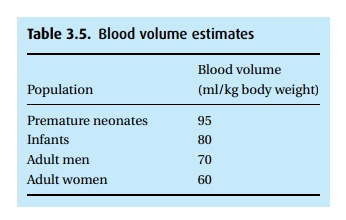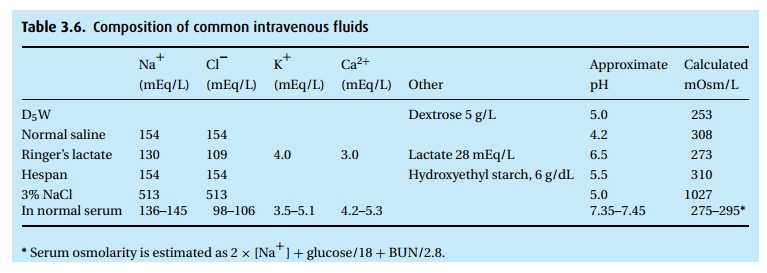Chapter: Essential Anesthesia From Science to Practice : Clinical management : Vascular access and fluid management
Fluid types - Fluid management
Fluid management
As
mentioned at the start of this chapter, we are mostly water, actually salt
water with some other chemicals thrown in for good measure. The intravascular
compartment, replete with cells and proteins, differs from the rest of the
body. In fact the blood volume also differs with age and sex (Table 3.5). We may lose fluid in a number of ways, from
the obvious – hemorrhage, urine, vomiting – to the less obvious – sweat,
evaporation from exposed viscera or trachea, transudation between compartments.
While fluid escapes from anywhere, replacement occurs only through the
intravascular compartment.

Fluid types
Many
types of fluids are available for intravascular administration (Table 3.6).
·
Crystalloid
·
Hypotonic solutions With an osmolality less than that of serum
(285–295
·
mOsm/kg), these are rarely used in anesthesia (except pediatrics),
because very little of the infused fluid remains intravascularly (<10% of D5W), elec-trolytes are
diluted, and cells swell.

·
Isotonic solutions Preferred, though still only about 25% of the
infused volumeremains intravascularly, with the rest seeping into the
interstitial space; representatives include 0.9% sodium chloride (also known as
normal saline) and lactated Ringer’s (which also contains potassium and
calcium).
·
Hypertonic solutions Available in solutions from 1.8% to 10% NaCl;
3% is themost common. While almost 65% of the infused volume remains
intravas-cularly, these solutions may cause cellular dehydration,
hypernatremia, and hyperchloremic metabolic acidosis.
·
Colloid Containing large molecules, these solutions
tend to remain intravascu-larly (assuming capillary integrity).
·
Hespan® (hetastarch, hydroxyethyl starch) Associated with coagulationabnormalities with
infusions of >1 L.
·
Pentastarch Hetastarch’s younger brother, allegedly with
less effect on coagu-lation.
·
Albumin Very expensive; often refused by Jehovah’s
Witnesses.
·
Blood or blood components Associated with many risks and expense (see
below). Blood substitutes We need
solutions capable of carrying oxygen, without therisks and expense of blood
transfusions. Unfortunately, as of this writing, these solutions – including
perfluorochemical emulsions, stroma-free haemoglobin and synthetic hemoglobin –
remain in clinical trials.
Related Topics